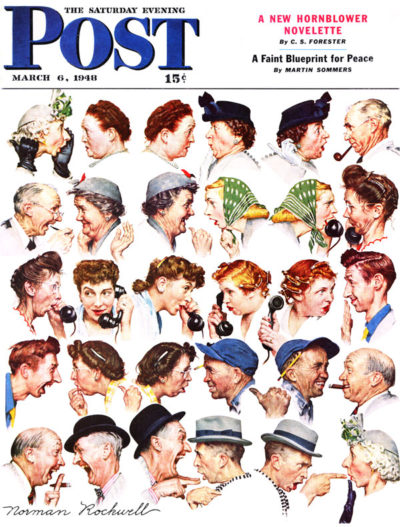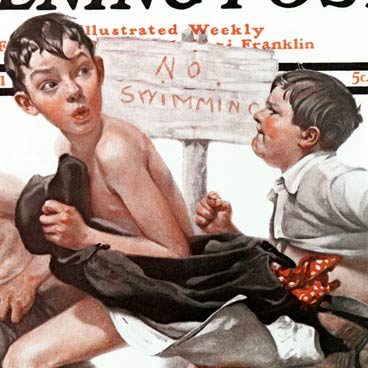You know these classic Rockwell paintings, but do you know the details behind them?
The Gossips—March 6, 1948

It seems Rockwell had a neighbor who started a disagreeable rumor about him. What can one do about a nasty gossip? Well, if you are a famous illustrator, you can paint a cover about it.
It started with just a couple of people, then it just grew, leaving Rockwell in need of more models. The result, said the editors, is that we see “almost the entire adult population of Arlington, Vermont.” As he worked on the project, the artist worried that his friends and neighbors might be offended, so he included his wife and himself. Mary Rockwell is second and third in the third row, spreading the rumor via rotary phone. In the gray felt hat in the bottom row is, of course, the artist himself (you can click on the image for a close-up). You’ll notice the lady at the end is the one at the beginning who started the rumor, and our friend Rockwell appears to be giving her a piece of his mind. Apparently, the neighbor who started the rumor in real life never spoke to Rockwell again. I have a feeling it was no great loss. The lesson here is: don’t anger someone whose Saturday Evening Post covers are viewed by millions.
No Swimming—June 4, 1921

These boys sure are hightailing it out of there! Even the dog is hauling tail (okay, sorry). Rockwell expert Robert Berridge wrote about this cover in a recent edition of The Saturday Evening Post magazine. “Franklin Lischke—the freckle-faced lad in the middle,” writes Berridge, was so taken with Rockwell’s work, he ended up studying art himself, becoming a successful commercial artist.
The question remained for decades: what were the boys running from? “Could it have been the pond owner,” Berridge asked, “an irritated bull, or a group of passing girls?” The model himself told Berridge. Answer at the end of this piece…
The Runaway—September 20, 1958

“The Runaway” is one of everyone’s favorite Rockwell covers. A neighbor of Rockwell’s, Richard Clemens, just happened to be a Massachusetts State Trooper and gladly posed for the artist, along with young Eddie Lock. After posing for this now iconic cover in 1958, Richard and Eddie didn’t see each other again until 1971 when they happened to find themselves sitting next to each other in an evening class (in logic) at a community college.
Besides the touching contrast between the large man and the little boy, there is a myriad of details Rockwell meticulously included: The old-time radio, the pies in the case, the coffee starting to perk and just turning brown, for example. The artist’s “mania for detail” extends to the stools: they were “spring-loaded,” causing the police officer’s seat to sink lower than boy’s. Even the chrome on the stools reflects the front of the diner.
By the way, the answer to the question of the running boys: why were they desperately trying to flee? They weren’t fearing the land owner or trying to hide their bare bottoms from an unexpected visit by girls; they were fleeing a swarm of bees! Thank you, Robert Berridge, for answering that long-standing question!
Become a Saturday Evening Post member and enjoy unlimited access. Subscribe now




Comments
I have a Norman Rockwell painting, called “tea time ” looking for the value of it .
Can u help me ?
The Crocker Art Museum in Sacramento CA will be doing a Rockwell exhibition in November 2012. even better, they will have all 323 SEP that Rockwell drew. A MUST SEE!
Always great to view these great paintings again. Nice to know the boys were escaping bees, I had no idea.
It is a truism that what we allow in our minds shows in our outward lives. Norman Rockwell’s mind was beautiful. His paintings are his mind on display.
I loved Norman Rockwell, and one of the highlights of my life was going to Stockbridge, where he lived, and seeing the original of a lot of his paintings.
He was wonderful. I always enjoy reading about him and seeing anything
he painted or sketched.